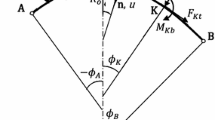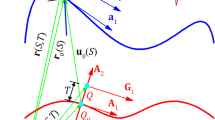Abstract
This paper presents a three node curved three dimensional beam element for linear static analysis where the element displacement approximation in the axial (ξ) and transverse directions (η and ζ) can be of arbitrary polynomial orders p ξ, p η and p ζ. This is accomplished by, first constructing one dimensional hierarchical approximation functions and the corresponding nodal variable operators in ξ, η and ζ directions using Lagrange interpolating polynomials and then taking the products (also called tensor product) of these hierarchical one dimensional approximation functions and the corresponding nodal variable operators. The resulting approximation functions and the corresponding nodal variables for the three dimensional beam element were hierarchical. The formulation guarantees C 0 continuity. The element properties are established using the principle of virtual work. In formulating the properties of the element all six components of the stress and strain tensor are ratained. The geometry of the beam element is defined by the coordinates of the nodes located at the axis of the beam and node point vectors representing the nodal cross-sections. The results obtained from the present formulation are compared with analytical solutions (when available) and the h-models using isoparametric three dimensional solid elements. The formulation is equally effective for very slender as well as deep beams since no assumptions are made regarding such conditions during the formulation.
Similar content being viewed by others
References
Ahmad S.; Irons B. M.; Zienkiewicz O. C. (1970): Analysis of thick and thin shell structures by curved elements. Int. J. Num. Meth. Eng. 2, 419–451
Babuska I.; Zienkiewicz O. C.; Gago J.; Oliveira E. R. de A. (1986): Accuracy estimates and adaptive refinements in finite element computations. New York: Wiley
Bathe K. J.; Bolourchi S. (1979): Large displacement analysis of three dimensional beam structures. Int. J. Num. Meth. Eng, 14, 961–986
Bathe K. J. (1982): Finite element procedures in engineering analysis. New Jersey: Prentice-Hall
Basu, P. K.; Szabo, B. A.; Rossow, M. P. (1977): Theoretical manual and user guide to COMET-X, An advanced computer program for stress analysis. Federal Railroad Administration, FRA/ORD-77/60
Basu, P. K.; Lamprecht, R. M. (1979): Some trends in computerized stress analysis. Proc. Seventh ASCE Conference on Electronic Computation. St. Louis. 312–330
Brombolic, L. J.; Gould, P. L. (1969): Finite element analysis of shells of revolution by minimization of the potential energy functional. Proc. of the Symposium on Application of Finite Element Method in Civil Engineering. Vanderbilt University. 279–307
Ferguson G. H.; Clark R. D. (1976): A variable thickness, curved beam and shell stiffening element with shear deformations. Int. J. Num. Meth. Eng. 14, 581–592
Gallagher R. H. (1975): Finite element analysis fundamentals. New Jersey: Prentice-Hall
Peano A. G. (1976): Hierarchies of Conforming finite element for plane elasticity and plate bending. Comput. & Maths. with Appl. 2, 211–224
Prezemieniecki J. S. (1968): Theory of matrix structural analysis. New York: McGraw-Hill
Surana, K. S.; Kalim, P. (1985): Finite element formulation for axisymmetric shell heat conduction with temperature gradients. Winter Annual Meeting of ASME. Miami Beach, Florida. 17–21
Surana K. S.; Phillips R. K (1987): Three dimensional curved shell finite elements for heat conduction. Comput. & Struct. 25/5, 778–785
Surana K. S.; Sorem R. M. (1989): Geometrically nonlinear formulation for three dimensional curved beam elements with large rotations. Int. J. Num. Meth. Eng. 28, 47–73
Surana, K. S.; Nguyen, S. H. (1989): p-Version hierarchical two dimensional curved beam element for elastostatics. Comput. & Struct. (under review)
Surana, K. S.; Nguyen, S. H. (1990a): Completely hierarchical p-version two dimensional curved beam element for laminated composites. Presented at the Thirteenth Annual Energy Sources Technology Conference and Exhibition. New Orleans, Louisiana
Surana, K. S.; Nguyen, S. H. (1990b): p-version two dimensional curved beam element for linear elastodynamics. To be presented at ASME Pressure Vessel and Piping Conference in Tennessee
Zienkiewicz O. C.; Iron B. M.; Campbell J.; Scott F. (1970): Three dimensional stress analysis, high speed computing of elastostructure. Proceedings of the Symposium of International Union of Theoretical and Applied Mechanics in Liege. 1, 413–432
Author information
Authors and Affiliations
Additional information
Communicated by S. N. Atluri, May 25, 1990
Rights and permissions
About this article
Cite this article
Surana, K.S., Nguyen, S.H. Hierarchical three dimensional curved beam element based on p-version. Computational Mechanics 7, 289–298 (1991). https://doi.org/10.1007/BF00370042
Issue Date:
DOI: https://doi.org/10.1007/BF00370042




